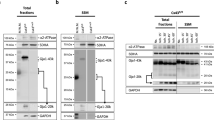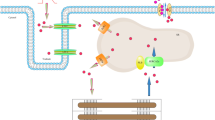Abstract
Experiments were performed to determine the relative contributions of direct Ca2+-entry through the L-type Ca2+-current and of Ca2+-release from the sarcoplasmic reticulum (s.r.) to the intracellular [Ca2+]i-transient in isolated human atrial and ventricular myocytes from patients with severe heart failure and from non-failing controls. Cells were isolated from explanted hearts of patients undergoing transplantation because of severe heart failure due to dilated or ischemic cardiomyopathy or from donor hearts which could not be transplanted for technical reasons. Ca2+-current densities were −2.1±0.6 pA/pF in atrial cells, −4.8±0.5 pA/pF in cells from patients with heart failure and −3.2±0.5 pA/pF in non-failing controls. [Ca2+]i-transients were significantly smaller in heart failure (370±33 nM) compared to ventricular cells from non-failing hearts (760±69 nM, p<0.05). Atrial myocytes had average [Ca2+]i-transients of 505±38 nM. After incubation in ryanodine the average [Ca2+]i-transients were not significantly different between different cell types.
The results indicate that the relative contribution of Ca2+ released from the sarcoplasmic reticulum to the [Ca2+]i-transient is significantly smaller in heart failure. The absolute contribution of the L-type Ca2+-current to the transient seemed to be comparable in all cell types investigated. As the [Ca2+]i-transient in the presence of ryanodine was comparable in size in all cells, changes of the intracellular [Ca2+]i-transient in heart failure are mainly due to alterations of s.r. function in these cells.
Similar content being viewed by others
References
Beuckelmann DJ, Wier WG (1988) Mechanism of release of calcium from sarcoplasmic reticulum of guinea-pig cardiac cells. The Journal of Physiology (London) 405: 233–255
Beuckelmann DJ, Näbauer M, Erdmann E (1992) Intracellular calcium handling in ventricular myocytes from patients with terminal heart failure. Circulation 85: 1046–1055
Bustamante JO, Watanabe T, Murphy DA, McDonald TF (1982) Isolation of single atrial and ventricular cells from the human heart. Canadian Medical Association 126: 791–793
Flesch M, Putz F, Schwinger RHG, Böhm M (1996) Functional relevance of an enhanced Na+−Ca2+-exchanger in the failing human heart. Annals of the NY Academy of Science 779: 539–542
Grynkiewicz G, Poenie M, Tsien RY (1985) A new generation of Ca2+-indicators with greatly improved fluorescence properties. The Journal of Biological Chemistry 260: 3440–3450
Gwathmey JK, Copelas L, MacKinnon R et al. (1987) Abnormal intracellular calcium handling in myocardium from patients with end-stage heart failure. Circulation Research 61: 70–76
Krüger C, Erdmann E, Näbauer M, Beuckelmann DJ (1994) Intracellular calcium handling in ventricular myocytes from cardiomyopathic hamsters (strain BIO 14.6) with congestive heart failure. Cell Calcium 16: 500–508
Li GR, Ferrier GR, Howlett SE (1995) Calcium currents in ventricular myocytes of prehypertrophic cardiomyopathic hamsters. American Journal of Physiology 268: H999-H1005
Marban E, Wier WG (1985) Ryanodine as a tool to determine the contributions of calcium entry and calcium release to the calcium transient and contraction of cardiac purkinje fibers. Circulation Research 56: 133–138
Mewes T, Ravens U (1994) L-type calcium current of human myocytes from ventricle of non-failing and failing hearts and from atrium. Journal of Molecular and Cellular Cardiology 26: 1307–1320
Ming Z, Nordin C, Siri F, Aronson RS (1994) Reduced calcium current density in single myocytes isolated from hypertrophied failing guinea-pig hearts. Journal of Molecular and Cellular Cardiology 26: 1133–1143
Näbauer M, Calewaert G, Cleemann L, Morad M (1989) The mechanism of Ca2+-release in mammalian cardiac myocytes requires Ca2+ influx through the Ca2+-channel. Science 244: 800–803
Nagasaki K, Fleischer S (1988) Ryanodine sensitivity of the calcium release channel of sarcoplasmic reticulum. Cell Calcium 9: 1–7
Rousseau E, Smith JS, Meissner G (1987) Ryanodine modifies the gating behavior of single Ca2+-release channels. American Journal of Physiology 253: C364-C368
Studer R, Reinecke H, Bilger J, Eschenhagen T, Böhm M, Hasenfuss G, Just H, Hotz J, Drexler H (1994) Gene expression of the cardiac Na+−Ca2+-exchanger in endstage heart failure. Circulation Research 75: 443–453
Wier WG, Yue DT, Marban E (1985) Effects of ryanodine on intracellular [Ca2+]i-transients in mammalian cardiac muscle. Federation Proceedings 44: 2989–2993
Author information
Authors and Affiliations
Rights and permissions
About this article
Cite this article
Beuckelmann, D.J. Contributions of Ca2+-influx via the L-type Ca2+-current and Ca2+-release from the sarcoplasmic reticulum to [Ca2+]i-transients in human myocytes. Basic Res Cardiol 92 (Suppl 1), 105–110 (1997). https://doi.org/10.1007/BF00794074
Issue Date:
DOI: https://doi.org/10.1007/BF00794074




